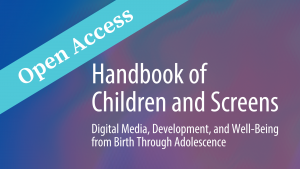
Media use is associated with impacts to adolescent behavior and health regardless of gender, but there are some risks unique to boys’ online experiences that can affect physical and mental health. What are the impacts of violent media, pornography, and video game play on the behavior and mental health of boys and young men? How do male gender roles portrayed by social media and digital platforms influence boys’ developing identity? What can parents and caregivers do to combat media messaging and communicate with their male children?
Media Use and Its Risks for Boys
Tech Addiction and Boys
“One hundred percent of my clients who are coming for tech addiction in the last 12 years were assigned the gender at birth of male with no exceptions, which is pretty striking,” says digital addiction expert and psychologist Ed Spector, PsyD. Spector posits that one reason behind the disparity in tech use patterns may be the natural tendency in male adolescence for “rough and tumble” play. “I think of gaming as a sort of modern day electronic version of ‘rough and tumble play,’” says Spector, “and this may explain why there’s such a disparity in how guys and girls use technology.”
Effects on Developing Notions of Masculine Identity and Gender Roles
Boys’ usage of social media and other online platforms is similar to girls’ in that they are drawn to digital spaces where they can develop social connections and flex social status, but these spaces are also where they look for blueprints about their gender identity, says Andrew Reiner, Senior Lecturer at Towson University. “Many boys look to cyberspace as a place where, apart from parents, they can have their idealized identity as competent men reflected back to them. These are spaces where boys are getting the same messages they receive offline that being cocksure, physically strong, aggressive, and chasing the material trappings their sports and influencer idols flaunt will make them successful men.”
Media use is associated with the endorsement of more “traditional” gender roles by boys, says Soraya Giaccardi, Senior Researcher, Norman Lear Center, University of Southern California. These can include viewing being “masculine” as:
- Being “self-sufficient” – never asking for help or relying on others
- Being “tough” – not openly sharing feelings struggles
- Associating women with caregiving and taking care of households and men being “breadwinners”
- Endorsement of the idea that girls should be the gatekeepers of sexual relationships while boys should be the pursuers
- Hypersexuality – that “real men” should have as many (assumed heterosexual) partners as they can
- Use of aggression – that men should use violence or physical force to gain respect
Social Media and Body Image Problems
Historically, most eating disorder research has focused primarily on female thinness and weight loss and may be missing social media’s influence on male manifestations of disordered eating and body image problems, says Jason Nagata, MD, MSc, Associate Professor, Department of Pediatrics, School of Medicine University of California, San Francisco.
Boys are less likely than girls to have private accounts, therefore allowing for public followings, and male selfies are more likely than female selfies to be full body photos that show muscularity and leanness, Nagata says, which may lead to subsequent disordered body image and eating behaviors that chase these new ideals of male attractiveness. Studies have shown that Instagram use in boys and men is associated with some disordered eating or muscle dysmorphia behaviors to achieve an idealized muscular body type, he says. These behaviors can include:
- Meal skipping
- Disordered eating
- Protein overconsumption
- Restricting carbohydrates and fats
- Muscle dysmorphia (also known as bigorexia or reverse anorexia) – a preoccupation or obsession with insufficient muscularity
- Use of performance and appearance enhancing drugs like anabolic steroids, androstenedione, and creatine
- Drive for compulsive or excessive exercise
YouTube and Influencer Culture
The content seen on YouTube may be more of an influence on boys’ developing identity than video games, says Reiner. A 2023 Pew report estimated 96% of teen boys use YouTube. As a haven for young male influencers, this platform is a space where many boys learn limiting ideals about a monolithic body ideal (big chest, biceps, six-pack abs) that can lead to body dysmorphia, as well being influenced towards versions of masculinity that discourage hard work, glorify wealth, and encourage style over substance, he says. “It’s also where they’re directly and indirectly swayed in their political and cultural worldview, where many white nationalist groups first engage with and lure boys who feel alienated and culturally rejected.”
Video Gaming’s Double-Edged Sword
Over 60% of boys today identify as gamers compared to 17% of girls. Research indicates that spending significant time in first-person shooter games or other violent video games can leave boys feeling more hostile and aggressive afterwards, says Reiner. On the other hand, these same games are now a primary space for boys to create and maintain friendships that may help mitigate against the “emotional disconnect and isolation crisis we’re seeing in boys and men,” he notes. That said, Reiner notes that newer research shows that in-person contact is far better for mental and physical health – which will only help boys, who are less likely to maintain friendships face to face.
Screen Time and Insufficient Physical Activity
Overall, research indicates that boys who are on screens for large swaths of time per day, especially for television, Internet browsing, or video games, are mostly sedentary and do not get recommended amounts of daily physical activity, says Nagata.
Risk-Taking Behavior
Research indicates media use among boys and men is associated with risk-taking behaviors, says Giaccardi. This can include risky driving behaviors, substance use, and sexual risk-taking.
Considerations Specific for Young Black Men
A systematic review of research exploring the specific impact of social media on the lives of young Black boys and men has unearthed viewpoints of masculinity and inclusion in media specific to this population, says Desmond Upton Patton, PhD, Brian and Randi Schwartz University Professor, Director, SAFELab, University of Pennsylvania. “A number of individuals felt rejected from the political market, that their intersectional identities were not wanted and desired, that the ways in which racism played out affected their ability and their marketability within the economic market, which then informed and influenced feelings of rejection and powerlessness, failure and inferiority, as well.”
On the other hand, Upton Patton notes that social media can be a place where young Black boys and men can find public love and recognition of their intersectional identities and their manhood that can reinforce their sense of self. “It allows individuals who feel dehumanized to craft an alter ego that is an aspirational self.”
The role of respect and disrespect between individuals, crews, or cliques are important factors to media use with young Black men, says Upton Patton, and also contribute significantly to the role of online media in facilitating offline violence. He notes Twitter/X and other social media use by young boys that amplifies gang affiliations or expresses interest in gang involvement, as well as use of social media to get higher visibility, celebrity and notoriety by amplifying ideas around bravado and a posturing type of masculinity that suggests that toughness and willingness to fight at a moment’s notice. “Anyone who is working in the area of gun and gang violence and with young black men who are living in these particular types of neighborhoods should think about the amplification of social media behavior in engagement” in gang behavior, says Upton Patton.
Tips for Parents and Caregivers
Recognize the Limits of the Adolescent Brain
The adolescent brain’s frontal lobes are not yet fully developed, notes Spector. While young boys may be able to adopt technology much more quickly than the adults in their lives, they still do not have the problem-solving skills or wisdom that comes with age and a fully developed brain, he says. “They can’t issue-spot and know things like ‘Hey, I think that’s not going to go well.’ Whether it’s how to deal with someone who’s made a problematic response in a group text, or whether it’s realizing whether a gaming environment is toxic for them, they need us because their frontal lobes are just not developed.”
Model a Healthy Relationship to Media and Family Media Use Rules
“So much of this work involves doing self-work as well and reflecting on our own media habits, reflecting on our own attitudes,” says Giaccardi. Nagata also notes that a big predictor of child screen use is parent screen use. Encouraging healthy youth behaviors with digital media means role modeling with your own screen time practices and acknowledging your own struggles, he says. “If you set rules for the household, you should also follow them yourselves because your kids will tend to emulate what you do. If you say, ‘No phones at the dinner table,’ and then you’re texting with your friends at the dinner table, the kids are also going to go text their friends.”
It’s not that you have to be “perfect”, and, in fact, acknowledging your own struggles with media use and displaying corrective behavior can create better dialogue and understanding with youth, says Spector. “Messing up” and then talking out how you are trying to figure out a solution makes a child feel they are helping you out, and also avoids an overly lecturing “I must instruct you in the ways of digital citizenship” attitude that is not effective with adolescents, he says.
Be Present and Communicate Your Values
“Teens are trying to understand themselves and the universe, and they’re doing that these days through digital media. You need to be present, because if you are not present, there’s this parental vacuum that happens around the technology and then someone else comes in and teaches your kid their values,” says Spector. To communicate your values means engaging in ongoing open dialogue, co-viewing or playing, and, when necessary, setting limits to keep them safe, he says.
If you participate with your kids in some way in their gaming or media use, it opens conversations that are very powerful, says Spector, who shares a relevant example. “If I’m playing video games with my son and we get to a video game that is problematic in some way, that contradicts my values, how powerful is it that I can say, ‘Okay, this game is kind of fun. I get it. The story is kind of interesting and the gameplay is fascinating. But one thing that’s kind of cringey for me is just like how women are treated. And have you noticed that you can’t really play a female character in this game that’s powerful and all the women are basically sort of sexualized?’ To be able to have that conversation directly is so powerful and you can only have it if the dialogue is happening and if you’re participating with them.”
The Art of Conversations Around Tech Use
A guaranteed way to ensure an adolescent tunes out of a conversation about tech use is to sit them down and stare across the table and say “OK, now we’re going to talk about tech use,” says Spector. Instead, view conversations about media use as something you can do while already engaged or in proximity for other activities. “It’s less intimidating and they’re much more likely to be open with you,” he says. “Go for a walk and then talk, or talk when you’re driving home in carpool, have it be when you are more organically overlapping. Set aside in your mind when you can have these conversations.”
Ask curious questions that help you understand how they are feeling about the media content they are consuming and get them to talk about their interests, says Spector. Spector and Upton Patton suggest engaging with questions like:
- What’s the funniest thing you’ve heard about or seen on YouTube or social media?
- What’s the most upsetting or cringey or disturbing thing?
- What do you like?
- Who are you following on YouTube and why?
- What parts of TikTok are you exploring and who’s on your ‘For You’ page and why?
- Where are you posting and hanging out?
- Who are you talking to?
- Are you learning any new things on social media?
Having these conversations with a non-judgmental tone is important to getting children to shift their perspectives, says Giaccardi, even if you as a parent are very concerned with things that your child is saying or thinking. Upton Patton agrees. “It’s really important for parents having conversations with young people about their digital life to be very thoughtful around trust and rapport,” he says. “Do not oversurveil, but get deeper into the types of connections and engagements that young boys and men are having online.”
Build Trust Rather Than Restriction
Today’s youth are facing a growing number of online risks, including grooming and sexual and financial exploitation. Overfocusing on restricting access may mean that in a dangerous or difficult situation, a child may opt not to involve their caregivers in a critical moment. “If you have a sort of a policing state where you’re being too controlling, succeeding or not, kids are not going to open up with you because they’re going to be worried that you’re going to punish them. Then when they really need you the most, when really something bad happens, they aren’t going to reach out to you and ask for help,” says Spector.
Consider the Individual Child and Family in Limit-Setting
“At some point all parents are also going to have to monitor what their kids are doing. They’re going to have to set limits,” says Spector. However, he strongly urges parents to consider the individual child when doing so. “If you have a kid who’s really impulsive or shows poor judgment, then you’re going to start with a very restrictive environment and open it up as they start demonstrating maturity,” he notes. “Every family will be a little different in how they approach that.”
Nagata recommends a family media use plan that is informed by open and regular conversations with children about screen use challenges. As a family, agreements can be made for screen-free times such as meals or before bedtime. “Kids themselves will realize that social media may have risks or be related to poor mental health. And if children find that social media is causing more stress or anxiety than enjoyment, then they may consider alternative activities to make them feel more connected with others.”
Teach Critical Thinking With Content Consumption
Instead of fighting a possibly losing battle to get a child to stop engaging with some of their favorite online content, Giaccardi suggests teaching children to be critical media consumers. “One of my favorite things to say over and over is that ‘we can be critical of the things that we love.’ We can all become more mindful consumers, and this does not mean that you should throw away your favorite shows,” she says.
If parents do not have the time or ability to co-view the content their children are consuming, they can use time in the car or in other “small moments” to encourage this critical engagement and ask questions like, “What are you watching? What’s your favorite show? Tell me about something new that you’re really into,” in order to start dialogue on aspects of their favorite content that may bear some more critical thinking, suggests Giaccardi.
Ask Boys About Consent and Coercion
While research on sexual risk-taking by adolescents tends to focus on number of sexual partners or age at first intercourse, Giaccardi notes that “we miss a lot of information about sexual well-being when we focus only on those two things,” and recommends trying to gain insight into an adolescent’s understandings and attitudes around consent and coercion. “Do adolescents understand that coercion is a spectrum of behaviors? We’re not just talking about physical aggression, but we’re also talking about verbal coercion or using substances like alcohol or drugs to gain sexual access.”
Model and Encourage Vulnerability
Communicating and modeling values around gender norms and responsibilities can also counteract messaging boys are seeing in media, says Giaccardi. “We can do this by modeling and encouraging vulnerability. So much of masculinity involves rejecting the things that are considered feminine, which includes things like feelings and emotions. It’s really important that we allow for vulnerability.”
Build Awareness Around Body Image and Over-Exercise
Over-exercising can be an indicator of a developing body image problem, says Nagata, who urges proactive conversations to build awareness. “Any conversation with boys about some of these pressures to work out excessively or about body image is so important because most boys will never have anyone talk to them about this, since it’s so underrecognized,” he says. “Pediatricians, teachers, and counselors are mostly trained to look for this in girls. Having any conversation about these issues is already an important first step.”
Warning signs that a boy is developing a body image problem include having any kind of preoccupation about their appearance, body size, weight, or exercise in a way that’s really worsening their quality of life, says Nagata. This may manifest as always being at the gym to the point of not seeing friends, not eating out because meals at restaurants are not high-protein enough, and any other behaviors that start impairing daily functioning.
Emphasize the Positive Uses of Media for Connection and Joy
“There’s a lot of positive engagement that’s happening on social media,” says Upton Patton. Being able to help boys have a healthy and thriving social media environment is important, he says. “We need to help people find joy online as well to help connect young people to various outlets on social media and offline, so people experience more joy as well.”
Look for Other Conditions That May Be Behind Compulsive Tech Use
In his practice specializing in adolescents with digital addiction, Spector finds that most youth never just have a digital addiction problem. He calls the “four best friends” of compulsive media use to be anxiety, ADHD, autism, and depression. Identifying any one or more of these coexisting conditions can be the key to finding a way out of compulsive tech use. “The road that gets you to the compulsive pattern is often the road that gets you out,” says Spector. “If someone you love is struggling with compulsive tech use, you want to be sniffing around for what these other problems are, because the treatment needs to include both.”
Solve Power Struggles With Curiosity Instead of Animosity
Before getting into a power struggle around media use, parents and caregivers should strive to understand what may be underlying a big reaction to in-the-moment media use restriction, says Spector. “One of the first steps before you get into the power struggle is to understand what’s going on, starting with curiosity and questions,” says Spector. “Ask things like ‘How come every night when it’s time for dinner you don’t get off your game, you get real salty and problematic and it kind of explodes? What’s going on? What’s the game?’ Because oftentimes parents don’t understand that some of these games are really hard to stop in a short timeframe.”
There may be social implications to suddenly exiting a group game with friends such that the child may be banned from playing with the group in the future. Spector likens this to the digital equivalent of grabbing a kid in the middle of a basketball game and walking off. First, try to understand if social pressure may be the problem instead of just poor planning or executive functioning, he suggests. Once you get a handle on the reason they can’t leave the game, then you can more calmly back up and help them problem-solve the situation in a way that can take family needs into account. “Many teen boys are not able to pre-emptively have the executive skills to have that conversation, and a parent can help them figure out a “cutoff” time well before dinner time where they should not start another match or help them find games with short durations to play at that time of day that are easier to jump away from at a transition point,” he says.
Talk About Pornography
If you think your adolescent boy is not seeing pornography on the internet, think again, says Spector. The number of kids looking at porn on the internet “is so close to 100% that it’s almost irrelevant,” he says. Because almost all kids are being exposed to porn online – whether purposely or accidentally – it’s important for caregivers to prepare them for it in order to raise healthy kids in the digital age. “We have to have that discussion, which is very uncomfortable for a lot of parents,” he says.
Why is the discussion necessary? In Spector’s private practice he is seeing significant numbers of teens or young adult males with erectile dysfunction from excessive use of porn, which becomes an issue when they are growing into having a real life intimate relationship and are not able to have a positive intimate experience.
One of the unique challenges with pornography is that it is marketed as being “real,” notes Giaccardi. “Anything marketed as “real” can have particularly powerful effects. One of the first steps in discussing pornography with our children is highlighting the ways in which pornography is just as manufactured and scripted as other forms of media. ‘It’s not realistic, it’s scripted.’” From there, depending on child age, you can share your own personal concerns about pornography, such as how content is unregulated, possibly nonconsensual, or dangerous.
Address the Stigma of Mental Health
Many boys and men have a resistance to getting help for mental health issues that may be underlying or informed by their media use, says Reiner. Nagata also notes that there is a “stigma and underdiagnosing” of mental health issues in boys and men. “We see a lot of teenage boys who are not referred to care or diagnosed.” Particularly for body image or eating disorder problems, there are long delays in diagnosis because the criteria that clinicians and health care providers have devised are often based on female data.
Upton Patton is encouraged by observing some increased positive and vulnerable conversations around mental health across social media platforms, particularly from young Black boys and men looking to connect with others and access services.
Evaluate New Technologies and Their Risks
As a clinical expert in digital addictions, Spector notes that “every six months I feel ignorant again,” because of how rapidly the technologies being used by youth are changing. While it’s almost impossible to become an expert in every new technology, he feels it’s important as caregivers to assess new technologies and platforms with enough understanding to spot risk factors, potential dangers to privacy, and how the new technology may play out in use by children before bringing it into the home.
Cultivate Awareness of Media Role in Radicalization
Radicalization of young men on social media and video games is a risk that parents and caregivers should stay attuned to, says Giaccardi. Research indicates that YouTube, in particular, lends itself to radicalization because kids don’t even need to be looking for certain topics in order for the algorithm to start showing them radicalizing content on their feed, she says.
Reiner notes that boys and young men without strong connections with father figures are going to places like YouTube and finding influencers that are strongly affecting their developing notions of masculine identity, including white nationalist groups. In his own research, Reiner has found that even boys who have good relationships with their fathers are initially lured into the “Manosphere” for other reasons, such as tips on building wealth. “One of the things that is so insidious is that a lot of these white nationalist groups will indirectly post things that end up becoming a kind of propaganda that really lures boys in. For a lot of boys who already feel socially alienated and isolated, which is a larger number of boys than we realize, they’re really preying on that,” he says.
Put Pressure on Content Creators
There has been slow progress over time with depictions and narratives around masculinity and gender norms in media, says Giaccardi. However, what progress has occurred is due in part to consistent pressure on content creators to widen the scope of gender presentations and roles, she says, and keeping this pressure up can help continue to improve these media depictions of gender roles.










